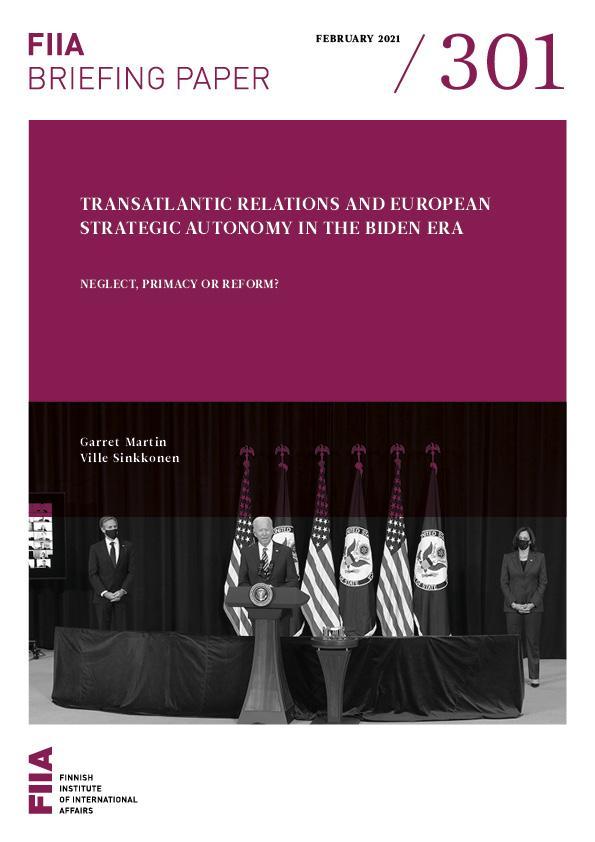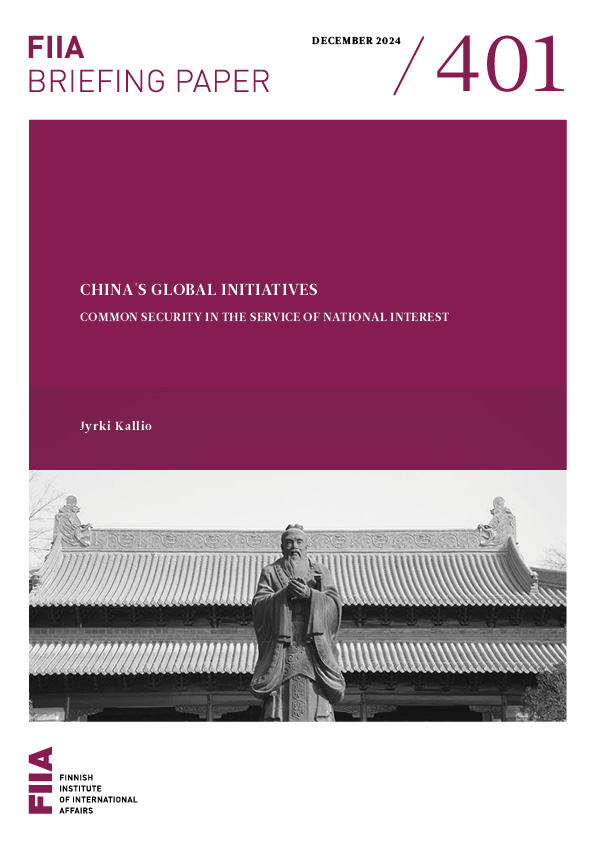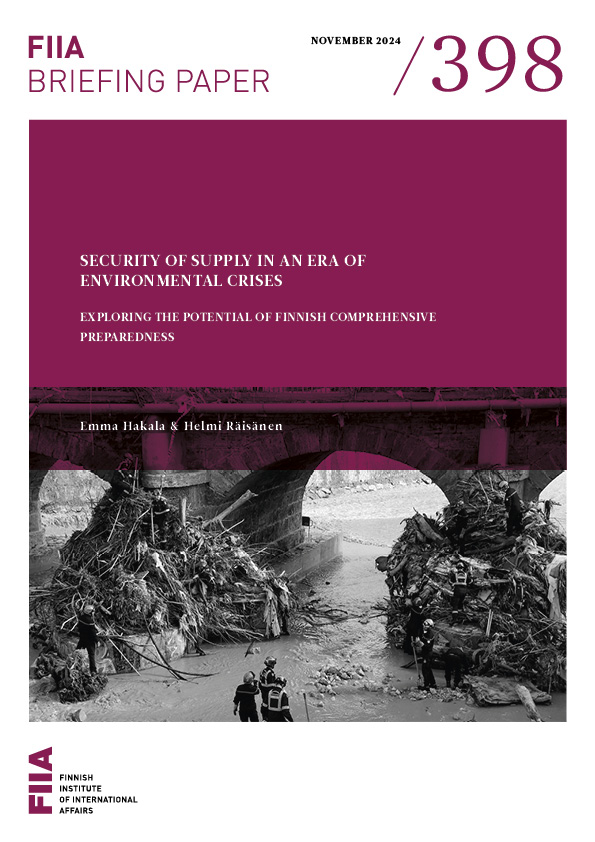- The relief in Europe following Joe Biden’s election has been tempered by uncertainty as to how the new administration might approach transatlantic relations. This paper lays out three paths that the US could take.
- The benign neglect model assumes that Washington will be consumed by domestic challenges and competition with Beijing, de facto downgrading Europe as a priority.
- In the primacy model, the US sees its leadership as indispensable for sustaining the international order and battling authoritarianism. The US would expect Europe to follow its lead, while old reservations about European strategic autonomy would resurface.
- The major reform model would see a humbler US foreign policy, understanding that it cannot repair the fragile international liberal order alone. Supporting European strategic autonomy would be key in devising a new transatlantic division of labor.
- Domestic challenges and ingrained policy habits mean that the US will likely gravitate toward neglect or primacy in its dealings with Europe. A major reform of the transatlantic relationship, while desirable, would require significant political will and investment on both sides of the Atlantic.
Introduction
Europe breathed a sigh of relief after Joe Biden’s victory in the 2020 presidential election, following a challenging period for transatlantic relations under Donald Trump. However, having a more pro-Europe president in the Oval Office might not be enough to fix a transatlantic partnership in need of reform.
Europeans still have many reasons to temper their expectations, understanding the numerous competing priorities, at home and abroad, that will vie for the attention of the Biden administration. Washington will have some very difficult choices ahead. Amidst this uncertainty, this Briefing Paper presents three distinct models that Biden could pursue, with a focus on what each could mean for Europe in general, and its ambitions of strategic autonomy.
The turmoil of the Trump years
Donald J. Trump’s abrasive rhetoric, transactional approach, and at times hostile policies over the course of four years caused great consternation. But Europe’s confidence was even more shaken by the fact that Trump questioned both the United States’ traditionally sacrosanct guarantee of the continent’s security, as well as its historical role in upholding the international rules-based order.
Thankfully, Europeans’ worst fears regarding the Trump presidency failed to materialize. Trump did not withdraw the US from NATO; instead, the US substantially invested more than it had during the Obama years in the European Deterrence Initiative (EDI), designed to bolster NATO’s Eastern flank. Yet such an example was more the exception than the norm, with the relationship between Europe and the US generally combative. Trump constantly berated allies about the state of burden-sharing within NATO, going as far as to present the United States’ commitment to Article V security guarantees as conditional rather than iron-clad. Trump also referred to the EU as a foe and resorted to secondary sanctions that effectively stifled Europe’s ability to defend the Iran nuclear deal. He likewise shunned many multilateral fora of cooperation that Europeans deem vital for upholding their values and pursuing their interests, such as the Paris climate agreement or the World Health Organization (WHO).
Therefore, it is unsurprising that the push for European strategic autonomy, defined as a more holistic drive to allow Europe to “shape international politics based on a distinct set of European values and interests”,[1] has gained momentum in the last four years. Concerned about the reliability of the US as an ally under Trump, increasing voices in European capitals argued that it was time for the EU to develop the requisite capabilities and will to forge a more independent path in the international arena when necessary.
The Biden administration: Relief and trepidation in Europe
President Biden presents a very welcome break from his predecessor, pledging that “America is back” and that diplomacy will be “at the center of our foreign policy”.[2] He is also a firm believer in alliances, surrounding himself with an experienced team of committed transatlanticists.
The new president has lost no time in trying to reassure America’s allies. This included announcing the United States’ re-entry into the Paris climate accord and reversing its withdrawal from the WHO. Shortly after being confirmed by the Senate, Secretary of Defense Lloyd Austin made his first phone call to NATO Secretary General Jens Stoltenberg to underline the importance of the alliance to the US.
At the same time, however, there are many reasons to temper Europe’s optimism. The tragic spectacle of the January 6 storming of the Capitol was a dramatic reminder that many of Biden’s immediate priorities will be domestic in nature.
First, his administration will have to contend with the economic fallout of the Covid-19 pandemic and organize a mass vaccination operation. Both tasks are complicated by Biden’s razor-thin electoral mandate in a deeply polarized country. In the longer run, revitalizing American democracy at home might very well take precedence over ambitious international goals, reflected in Biden’s pledge to pursue a foreign policy for the American middle class.
Additionally, Europe cannot ignore the hardening bipartisan consensus in Washington D.C. in support of great-power competition, especially against China. If combating Beijing’s influence became all-consuming for the US, this could very well affect its bandwidth for engaging with Europe.
The forecast for transatlantic relations is still marked by significant uncertainty. With many domestic and international challenges, the Biden administration will have difficult choices ahead, which could be very impactful for Europe in general, and its ambitions of strategic autonomy. In the past, US views toward common European defense initiatives have ranged from downright hostility to healthy skepticism.[3] It is not yet clear whether the Biden administration will demark itself from its predecessors, and nor is it obvious whether a more friendly US ally might take the wind out of the European strategic autonomy sails.
In light of this significant uncertainty, this Briefing Paper attempts to conceptualize several paths that the Biden administration might take, and what they would mean for Europe, by outlining three distinct models. Each model is built around two key variables, namely the level of US investment or commitment to Europe and the level of American confidence in European ambitions to develop its strategic autonomy and bolster its capabilities (see Table 1).
Table 1. Three models for the Biden administration’s engagement with Europe
|
|
Level of US investment in/commitment to Europe |
Level of US confidence in Europe’s aspirations and capabilities |
|
Model 1: Benign neglect |
Low |
Low |
|
Model 2: Primacy |
High |
Low |
|
Model 3: Major reform |
High |
High |
Model 1: Benign neglect
The first option, benign neglect, would involve low US investment in Europe coupled with low confidence when it comes to both the development of European capabilities and its levels of ambition.
In this model, the Biden administration would adopt a strong ‘China-centric’ approach. The new president would essentially accept the great-power competition paradigm of the Trump years, even if he might adopt different tactics than his predecessor, and be open to closer consultation with allies in Europe.
This path would hold plenty of appeal for Biden. It would acknowledge the geopolitical challenge posed by a rising China to US interests across the world. There is strong bipartisan support for countering Beijing, so this course could assist Biden’s goal of addressing the deep domestic polarization in the US. Moreover, tackling China’s unfair economic practices would be consistent with the new president’s pledge to make US foreign policy work for the middle class.[4]
Pursuing a China-centric model would have significant repercussions for other key US foreign policy goals. The Biden administration would remain committed to rejuvenating democracy at home, but it would be less concerned about doing the same abroad. The planned ‘Summit for Democracy’ would only aim for symbolic gestures, since countering Beijing would require building a large international coalition, including working with autocratic regimes.
As for transatlantic relations, we would still expect to see some signs of thawing after the difficulties of the past four years. Biden would eschew the divisive rhetoric and actions taken by Trump toward the European allies. He has surrounded himself with key aides, such as Secretary of State Antony Blinken and National Security Advisor Jake Sullivan, who are committed to the transatlantic partnership; and he has already taken steps, such as rejoining the Paris Climate Accord or the WHO, that were welcomed on the other side of the Atlantic.
But these changes aside, this model would still see Europe downgraded as a priority for the US, and for various reasons. The clear prioritization given to competition with Beijing would naturally limit Washington’s bandwidth to engage with other parts of the world, including Europe.
Additionally, in this scenario, Biden’s transatlantic policy would largely be assessed through the lens of competition with China. The new administration would mostly invest time in Europe in areas where it could expect alignment on its China policy, such as the screening of foreign investment or Beijing’s unfair market practices; but that cooperation would have limits as Washington would still harbor doubts about the EU’s reliability. The recent EU-China Comprehensive Agreement on Investment suggests that Europe remains concerned about the economic repercussions of taking too assertive an approach toward Beijing. There would be little appetite in Washington as well for addressing other thorny disagreements with European partners. Digital tax or data privacy, for instance, would not receive much emphasis since they would offer fewer benefits for the goal of competing with China.
Transatlantic relations would also receive less attention because the Biden administration would assume that only limited action would be needed to restore faith in its leadership. As long as it avoided the harsh rhetoric and actions of the Trump years and signaled its continued commitment to Europe with some symbolic actions, such as restating its support of NATO, the US could then expect its allies to generally align with the goals of its China policy.
Finally, lack of confidence in European ambition would also make Washington wary of pinning too many hopes on the transatlantic partnership. Keen not to rock the boat and shaped by past failed experiences, the Biden administration would refrain from pushing Europe to bolster its defense capabilities. As such, the US would essentially ignore the concept of strategic autonomy, viewing its development as neither credible nor impactful.
Model 2: Primacy
The second option, primacy, entails high US investment in Europe coupled with low confidence regarding both the development of European capabilities and the level of ambition.
In this model, the Biden administration would still regard US leadership as ‘indispensable’ for sustaining a rules-based international order, even if it entailed considerable investments. The Biden administration would also consider the renewal of American democracy at home and defense of its cherished values abroad as two sides of the same coin.
On the surface, it seems as if domestic conditions are not favorable for the re-exertion of American primacy. Even putting aside the pandemic and political polarization, there is at best ambivalent public support for shouldering the costs of global leadership,[5] so the model does not fit perfectly with Biden’s pledge to prioritize the concerns of the American middle class. Yet primacy is still deeply ingrained within the Washington foreign policy establishment as the default approach in US foreign policy in the post-World War II era.[6] The allure of the familiar policy course may prove too hard to resist.
Adopting primacy would likely lead the Biden administration to define the international arena in terms of an ideological contest between democratic and authoritarian models of governance.[7] While China would factor prominently in this competitive framing, it would be viewed as part of a broader authoritarian challenge to liberal democracies, encompassing Russia along with ‘rogue regimes’ like Iran and North Korea. The Summit for Democracy proposed by President Biden would be a vital first step in combating this authoritarian trend, signaling that the US is ready to reclaim the mantle of leadership of the ‘free world’. In the primacy model, the meeting would be built around a transatlantic ‘core’ and restricted to a select group of liberal democracies, even at the risk of souring relations with uninvited states.
Quickly repairing the transatlantic rift caused by the Trump administration would be paramount for primacy to work. Re-establishing US leadership and credibility would require trust-building measures that reach beyond rhetorical support for NATO or re-engaging multilateral fora.
This could take the form of rescinding the steel and aluminum tariffs put in place by the Trump administration, agreeing on a joint EU-US agenda for WTO reform, or resolving divisive issues such as the regulation of big tech and data privacy.
This model, however, could prove problematic for European aspirations of strategic autonomy. Primacy rests on the assumption that enhanced European capabilities, especially outside of NATO, would make it more difficult for the US to persuade its allies to follow its lead. The US might also revive old reservations about the potential duplication of capabilities or discrimination against non-EU NATO member states, and wariness regarding Europe’s ability to manage internal divisions and maintain adequate levels of defense investments.
Biden’s team could also conclude that Europeans, if left to their own devices, might be wooed by Beijing or pressured by Moscow. Primacy presents a potentially attractive option for a US that hopes to forestall such eventualities.
Model 3: Major reform
The third path, major reform, would involve high US investment in Europe coupled with high confidence when it comes to both the development of European capabilities and its levels of ambition.
In this model, the Biden administration would not simply seek to repair the damage caused by Donald Trump’s policies. It would pursue a broader agenda, believing that the previous four years had revealed a crisis of US leadership and a crisis of international governance. The US would have to shore up a badly weakened multilateral order, challenged by great-power competition, the erosion of guard rails, such as the collapse of the INF Treaty, or the inability of the world to cooperate in tackling Covid-19.
The new administration would still pay attention to China’s rise, but it would not make it the lodestar of its foreign policy, preferring to prioritize major transnational challenges, such as climate change or pandemics. Since these are problems which, by their very nature, require the involvement of all major powers, the Biden administration would de-emphasize the opposition between democracies and autocracies and tone down the great-power competition paradigm. Instead, the US would adopt a fluid approach, building shifting coalitions depending on the issue, and blending competition and cooperation with China.
This major reform path would also rest on a profound rethinking of the US role on the world stage, shifting toward a more chastened internationalism. It would start with the recognition that rebuilding the United States’ credibility on the world stage and repairing the extensive damage of the Trump years will be a long-term endeavor. Allies would be well aware that US domestic politics could swing wildly again in four or eight years’ time.
This model would require the Biden team to accept that democratic renewal at home would mean shouldering less of a burden on the international stage. It would be premised on the US doubting its ability to effectively promote democracy abroad in the short to medium term. In this perspective, the planned Summit for Democracy would expressly concentrate on rebuilding at home as opposed to establishing a new bipolar opposition between democracies and autocracies.
However, this cautious approach would not mean major retrenchment. The US would accept that growing parts of public opinion, on the left and the right of the political spectrum, are less enthused about the costs associated with primacy. In turn, a less engaged US would require other powers to help rebuild a better and more robust system of international governance.
What would this approach of ‘humbled leadership’ mean for transatlantic relations and strategic autonomy?[8] Europe would be a key partner in this model, as a committed supporter of the international rules-based order and by virtue of its long-standing cooperation with the US. The Biden administration, in this case, would not simply engage in minor steps to repair ties with Europe, but pursue bolder actions to rethink the partnership.
This would start with Washington not viewing strategic autonomy as a threat, but consider it instead as a long-term asset to be actively encouraged. The Biden administration would opt for investing in strategic autonomy, regarding it as a wise bet to ultimately improve Europe’s capabilities, thereby allowing it to shoulder more of the burden on the world stage.
For this model to work, it would need a more strategic discussion about what better burden-sharing would mean geographically, especially determining a clear division of labor in key theaters of interest, such as the Eastern flank, the Indo-Pacific, or the Eastern Mediterranean.[9] Furthermore, it would depend on a thorough commitment to revitalizing political cooperation, whether within NATO or between the EU and NATO.
The ambition of this model would require a long-term effort and would not be without costs. A stronger Europe could at times mean more friction in the transatlantic partnership; but the benefits of a more capable ally would outweigh those costs and better serve the United States’ goal of shoring up the rules-based order.
Conclusion: Assessing potential transatlantic futures
Despite Europe’s relief at seeing Trump gone, the new Biden presidency hardly signals a problem-free future for transatlantic relations. To illustrate this, our paper has outlined three broad scenarios that the Biden administration could opt for. While each of our models is possible, they do differ in terms of feasibility, and nor are they equally desirable from the standpoint of either the US or Europe.
Model 1, the benign neglect option, is certainly feasible. Beyond the structural shifts in the international system and the bipartisan consensus on China, key players in Biden’s team, be they Jake Sullivan or White House ‘Asia Czar’ Kurt Campbell, have underlined the importance of Beijing’s challenge and the virtues of a tougher approach . China’s actions and the weight of events might also force Biden to pursue a more China-centric approach.
Benign neglect would, however, be a regrettable development for transatlantic relations. It would not only reduce US attention toward Europe, but also downgrade European agency in the relationship. Attempts to develop the ties with the US beyond the China frame – in the vein of the EU’s proposed ‘EU-US agenda for global change’ – would struggle to find traction in Washington. Facing polite indifference, the EU member states and institutions would be left to work out policy differences about strategic autonomy amongst themselves – an unsavory prospect for European Atlanticists, who regard deep American engagement in the continent’s affairs as vital for their security.
Model 2, primacy, is arguably the most likely outcome. There is an inherent appeal in reverting to familiar policies and restoring the status quo ante, and President Biden is steeped in the US global leadership of the late 20th and early 21st century. Moreover, early indications point to the Biden administration seeking to dramatically repudiate Trump’s neglect of values-based concerns in US foreign policy by placing leadership, democracy, and human rights front and center.
For the transatlantic relationship, primacy presents a double-edged sword. The US would remain invested in Europe, as it has throughout the post-World War II period, and it could be amenable to some concessions on thorny disputes. However, the US would prefer Europe to be a dependable junior partner and force multiplier in a ‘free world coalition’ against autocracy, which would leave little room for European strategic autonomy in any meaningful sense. Even if some European states, notably in the Baltics and Eastern Europe, would welcome such a return of traditional US leadership, primacy would constitute a missed opportunity to forge a stronger, more equitable and sustainable transatlantic relationship for the coming decades.
The major reform necessary for model 3, finally, does not appear very feasible, even if such a rethinking of US global engagement and the transatlantic relationship would be highly desirable given the major domestic and international challenges on both sides of the Atlantic. While many on Biden’s team acknowledge the imperative of a humble approach, the apparent urgency of thwarting China’s regional and global designs, as well as the weight of decades of foreign policy orthodoxy, make a major overhaul a hard pill to swallow. Moreover, political polarization means that the Biden administration may struggle to persuade allies that the US is willing to stay the reform course.
The major reform model would require the US not only to see Europe as a vital and trustworthy partner in tackling global challenges, but also to rescind the long-held belief that America is first among equals. On the European side, the new transatlantic agenda put forth by the EU certainly indicates that it prefers a broad renegotiation of its relationship with the US.[10] Yet such willingness to seize the initiative does not go far enough; it must be coupled with a concerted effort to make meaningful and forward-looking investments in capabilities.
The EU would therefore need to swiftly paper over internal divisions regarding its envisaged role in the world. This is no mean feat in a Union that includes states like Poland and Estonia, which worry about the sidelining of NATO, non-NATO members like Finland, which welcome the building of capabilities regardless of the framework within which such measures occur, and cheerleaders of strategic autonomy like France.[11] Domestic politics in member states are likewise important. Germany, traditionally Atlanticist but willing to explore strategic autonomy, as well as France, will be holding key elections in the near future (September 2021 and April–May 2022, respectively). The impact of these votes on European aspirations of strategic autonomy is by no means certain.
Regardless of which model Washington opts for, there will be different levels of apprehension, enthusiasm and activism on the old continent. The transition from the tumultuous presidency of Donald Trump to the Biden era holds both promise and anxiety for the future of the transatlantic relationship. It appears that Europeans will need to hold their breath for a little while longer after all.
Endnotes
[1] See N. Helwig, ‘EU Strategic Autonomy: A Reality Check for Europe’s Global Agenda’, FIIA Working Paper 119 (2020), https://fiia.fi/en/publication/eu-strategic-autonomy.
[2] J.R. Biden Jr., ‘Remarks by President Biden on America’s Place in the World’, The White House, (4 Feb. 2021), https://www.whitehouse.gov/briefing-room/speeches-remarks/2021/02/04/remarks-by-president-biden-on-americas-place-in-the-world/.
[3] See E. Brattberg, T. Valasek and T. Wright, ‘EU Defense Cooperation: Progress amid Transatlantic Concerns’, Carnegie Endowment for International Peace (2019), https://carnegieendowment.org/2019/11/21/eu-defense-cooperation-progress-amid-transatlantic-concerns-pub-80381.
[4] See J. Sullivan et al., ‘Making U.S. Foreign Policy Work Better for the Middle Class’, Carnegie Endowment for International Peace (2020), https://carnegieendowment.org/2020/09/23/making-u.s.-foreign-policy-work-better-for-middle-class-pub-82728.
[5] See Pew Research Center, ‘In a Politically Polarized Era, Sharp Divides in Both Partisan Coalitions’, Pew Research Center (17 Dec. 2019), 80–89, https://www.pewresearch.org/politics//data/wordpress/htdocs/wp-content/uploads/sites/4/2019/12/PP_2019.12.17_Political-Values_FINAL.pdf.
[6] See S.M. Walt, The Hell of Good Intentions: America’s Foreign Policy Elite and the Decline of U.S. Primacy (New York: Farrar, Straus and Giroux, 2019).
[7] See H. Brands, ‘Democracy vs Authoritarianism: How Ideology Shapes Great-Power Conflict’, Survival 60/5 (2018), 61–114.
[8] See J. Goldgeier and B. Jentleson, ‘The United States is not Entitled to Lead the World’, Foreign Affairs (25 Sep. 2020), https://www.foreignaffairs.com/articles/world/2020-09-25/united-states-not-entitled-lead-world.
[9] See O. Bel, ‘What European Strategic Autonomy Requires: Smarter Talk, More Action’, Atlantic Council (7 Jan. 2021), https://www.atlanticcouncil.org/blogs/new-atlanticist/what-european-strategic-autonomy-requires-smarter-talk-more-action/.
[10] European Commission, ‘Joint Communication: A New EU-US Agenda for Global Change’, European Commission (2 Dec. 2020), https://ec.europa.eu/info/sites/info/files/joint-communication-eu-us-agenda_en.pdf.
[11] For intra-European divisions, see U.E. Franke and T. Varma, ‘Independence Play: Europe’s Pursuit of Strategic Autonomy’, European Council on Foreign Relations (2019), https://ecfr.eu/special/independence_play_europes_pursuit_of_strategic_autonomy/.









